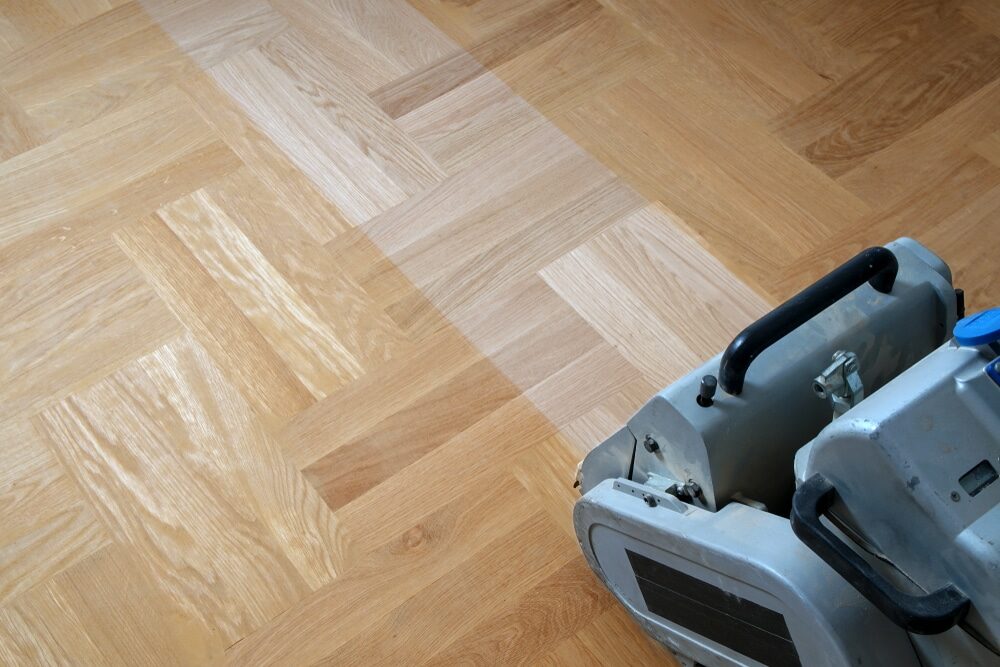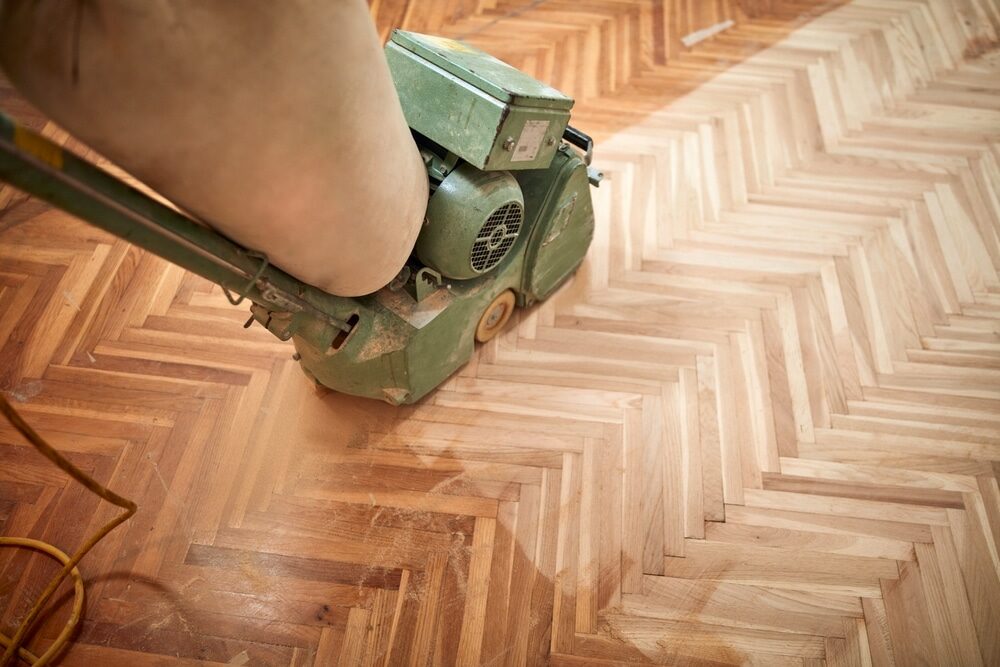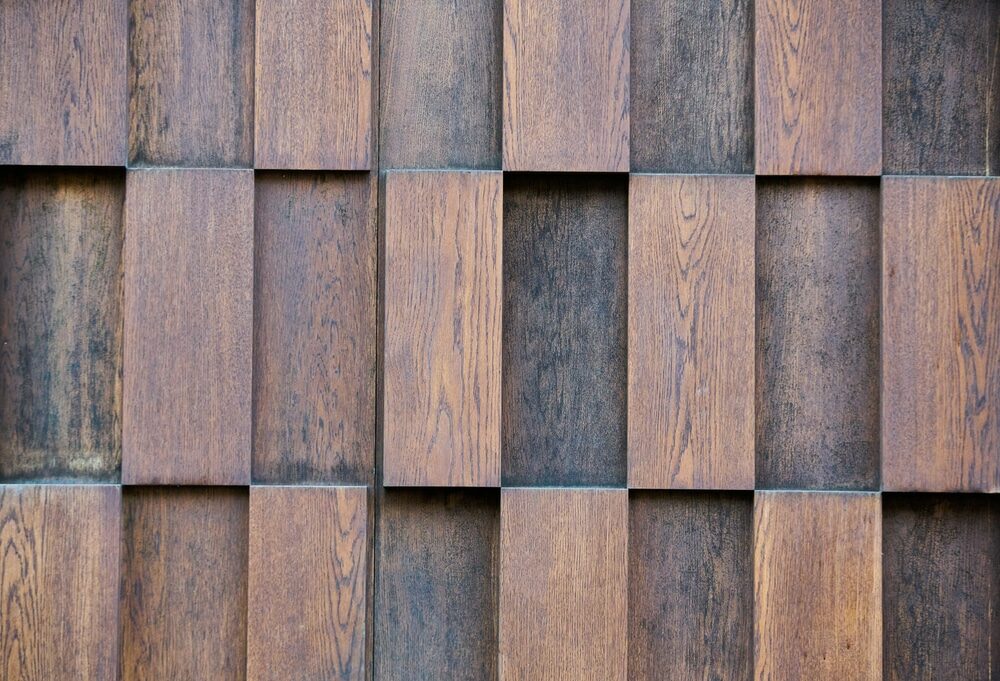London:
Nationwide:
From Restoration to Renewal: Transforming School Parquet Floors with British Craftsmanship
Posted on April 18, 2024
Parquet Floor Sanding
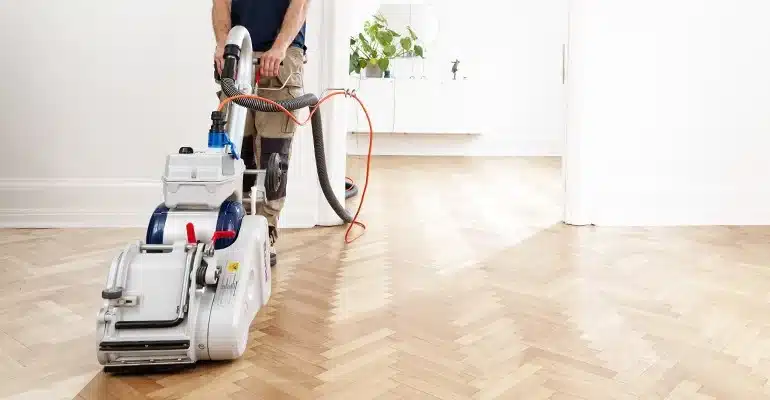
Reviving School Parquet Floors with British Craftsmanship
In the storied corridors of the United Kingdom’s educational institutions, the parquet floor stands as a silent custodian of history and tradition. These intricately patterned wooden floors, often laid down decades or even centuries ago, do more than just underpin the bustling life of a school; they add a touch of architectural elegance and bear witness to the countless footsteps of academia. However, as resilient as they are, the passage of time and the continuous tread of students and teachers can leave these historic floors in need of careful restoration. “From Restoration to Renewal: Transforming School Parquet Floors with British Craftsmanship” explores the fascinating journey of restoring these heritage-rich elements, emphasizing the role of skilled British artisans in bringing new life to old wood. This blog post delves into the practical and aesthetic benefits of maintaining and rejuvenating school parquet floors, highlighting how such endeavors not only preserve a piece of history but also renew the spaces for future generations of learners. Join us as we uncover the transformative process behind parquet floor restoration in schools, illustrating the challenges and solutions through case studies and expert insights. By understanding the craftsmanship involved in these projects, we aim to appreciate more deeply the value of preserving our educational heritage, ensuring these floors remain a functional and beautiful part of our school environments for years to come.
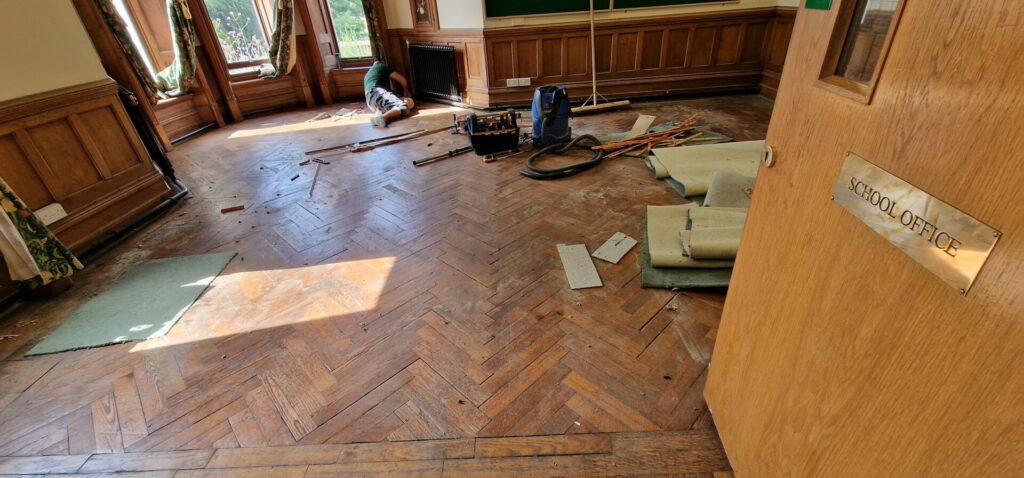
The History of Parquet Flooring in British Schools is Fascinating
Parquet flooring, a term derived from the French word ‘parqueterie’, refers to a mosaic of wood pieces that are used to decorate floors in an intricate geometric pattern. This style of flooring became popular in Britain during the Victorian and Edwardian eras, favored for its durability and the refined aesthetic it brought to any room.
- Origins and Rise to Prominence: The origins of parquet flooring in the UK can be traced back to the 17th century, when it was initially used in the homes of the affluent and the aristocracy. Its adoption in educational institutions began in the late 19th century, when there was a significant shift towards more robust and majestic school buildings that reflected educational prestige and national pride. Schools designed during this period often featured parquet flooring as a symbol of endurance and elegance.
- Architectural and practical advantages: People chose parquet floors not only for their aesthetic appeal but also for their practicality. Wood, being a naturally insulating material, provided a warmer surface underfoot compared to stone or tile, making it an ideal choice for the cooler British climate. Additionally, wood floors were easier to clean and maintain, a crucial factor in high-traffic environments like schools.
- Parquet in the 20th Century: Throughout the 20th century, as educational institutions expanded and the number of school buildings increased, so too did the use of parquet flooring. It became a common sight in classrooms, hallways, and assembly halls. The mid-20th century saw a peak in its popularity, coinciding with a period of significant educational reform and the construction of new schools across the UK.
- Cultural Significance: Parquet flooring in schools has also had cultural significance. It reflects a commitment to creating aesthetic learning environments that inspire respect and care from those who use them. The intricate patterns of the flooring are often seen as metaphors for the complexity and richness of education itself, symbolizing the foundational and interwoven nature of knowledge.
Today, many of these historic floors remain, albeit under the strain of decades of use. Their restoration not only preserves a visual and functional aspect of school heritage but also serves as a reminder of the UK’s longstanding commitment to educational excellence and architectural beauty. The ongoing efforts to maintain and restore these floors underscore the importance of heritage in the educational journey of future generations.
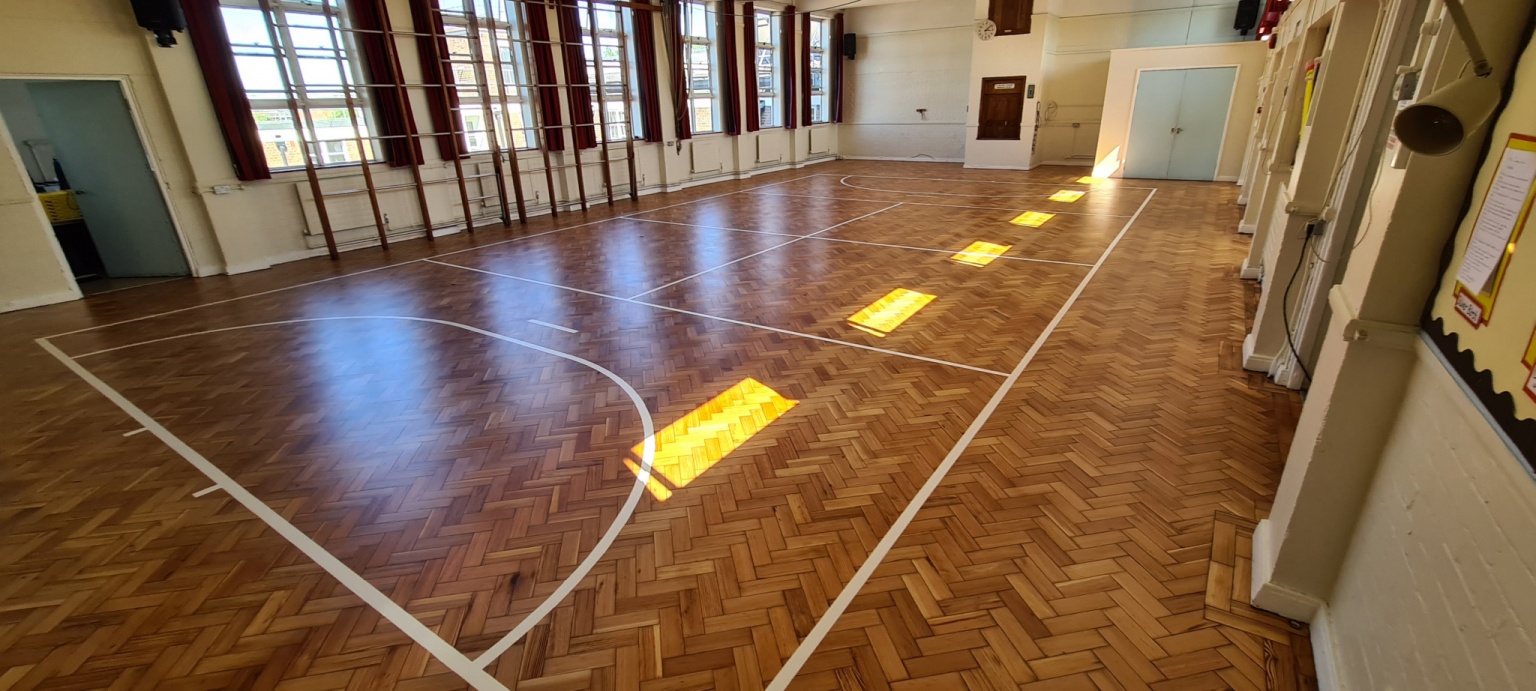
Assessing the need for restoration
Parquet floors in educational settings, revered for their durability and aesthetic appeal, inevitably face the ravages of time and frequent use. Recognizing the need for restoration is a critical step in maintaining the integrity and beauty of these historic floors. This section outlines the key indicators that signal a parquet floor requires professional attention, along with the impact of wear and tear over the decades.
Signs That a Parquet Floor Requires Professional Attention
- Visual Inspection: Look for signs such as lifting or loose wood pieces, significant scratches or gouges, and areas where the finish has worn away, exposing the bare wood.
- Uneven Coloration: Sunlight exposure and chemical wear can lead to faded or discolored patches. This uneven coloration not only affects the aesthetic uniformity but can also indicate deeper damage to the wood.
- Parquet floors in schools are susceptible to water damage from cleaning, spills, or environmental humidity. Signs of water damage include warping, buckling, or a spongy feel underfoot.
- Creaking Sounds: Excessive noise when walking on the floor often suggests that the adhesive holding the parquet pieces has degraded or that the subfloor may be damaged.
- Historical Considerations: For heritage-listed school buildings, any change in condition that might compromise the floor’s historic value is a significant concern.
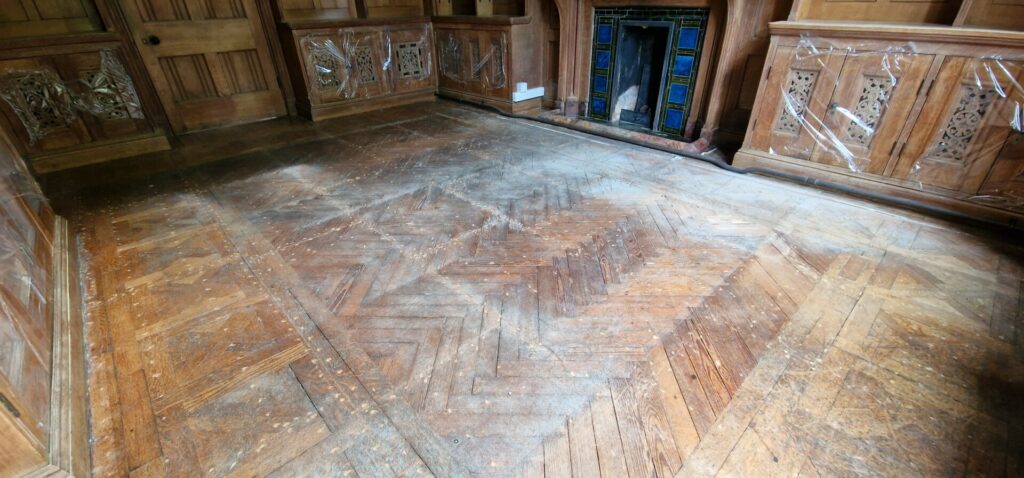
Over Decades, the Impact of Wear and Tear
Parquet floors in schools endure heavy foot traffic, resulting in gradual wear and tear that can diminish their functional and aesthetic qualities. Over decades, this wear and tear can lead to the following:
- Structural Weakness: Continuous pressure and stress can weaken the wood and the bonds between the parquet pieces, making them more vulnerable to damage.
- Aesthetic Deterioration: As the protective finish wears off, the wood becomes more susceptible to stains and further damage, which can significantly detract from the floor’s original charm.
- Increased Maintenance Costs: Without timely restoration, the floor may require more frequent and costly maintenance to address ongoing issues.
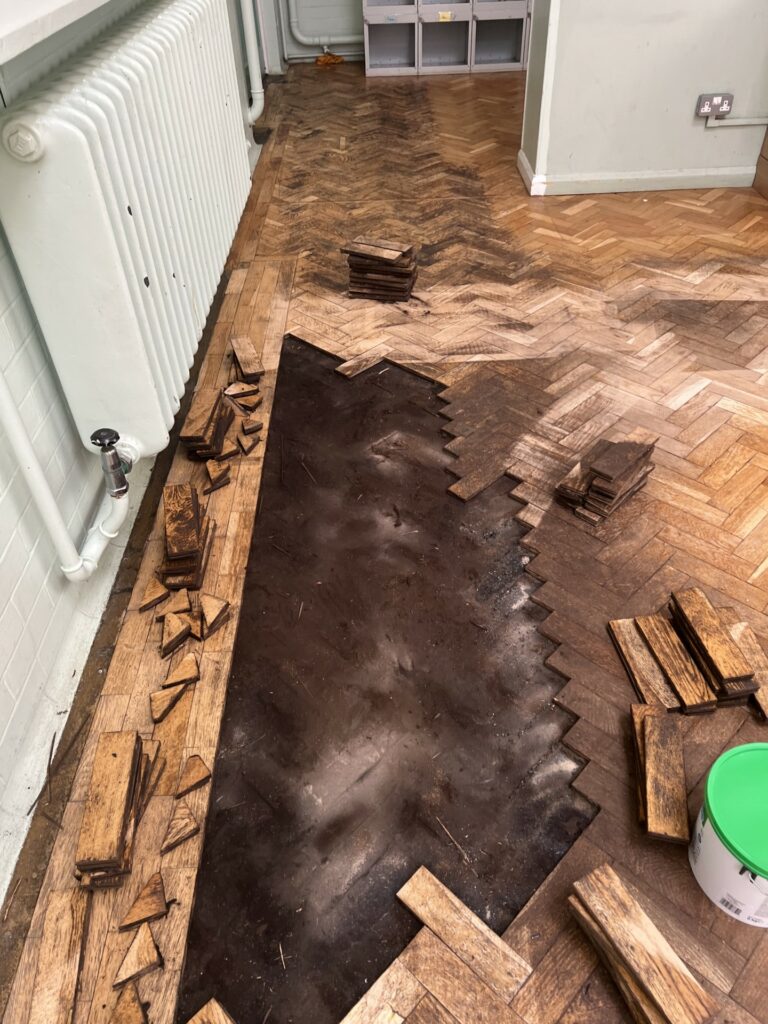
The importance of regular assessments
Regular assessments by professionals can help extend the life of parquet floors by identifying and mitigating minor issues before they escalate into major problems. A broader maintenance strategy should incorporate these assessments to preserve the floor’s historical and functional value. By understanding the signs of wear and their implications, schools can take timely action to restore their parquet floors, ensuring that these cherished elements continue to enhance educational environments for years to come. The restoration not only rejuvenates the floor but also contributes to a broader renewal of the space, inspiring both respect and admiration from all who walk these historic hallways.
Challenges Faced During Restoration
Restoring parquet flooring in schools presents a unique set of challenges. These challenges stem from the floor’s age, the complexity of the patterns, environmental factors, and the need to balance restoration with ongoing school activities. Addressing these issues requires careful planning and skilled craftsmanship.
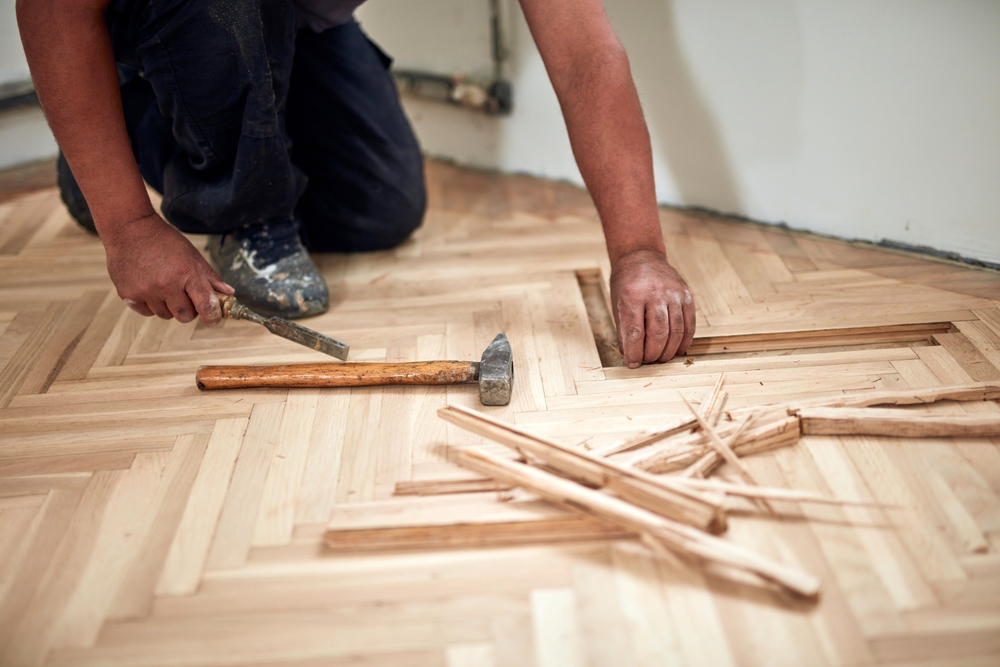
Dealing with Damage and Irregularities
- Extensive Wear: One of the most common challenges is addressing the extensive wear that has occurred over decades. This includes deep scratches, worn-away areas, and uneven surfaces, which can complicate the restoration process.
- Replacement of Damaged Tiles: Finding matching wood to replace damaged or missing tiles is often difficult, especially with older floors where the original wood type may no longer be readily available or has unique aging characteristics that are hard to replicate.
- Subfloor Issues: The condition of the subfloor is crucial to the integrity of the parquet above it. Moisture damage or structural weaknesses in the subfloor can pose significant challenges and require extensive repairs before the actual parquet restoration can begin.
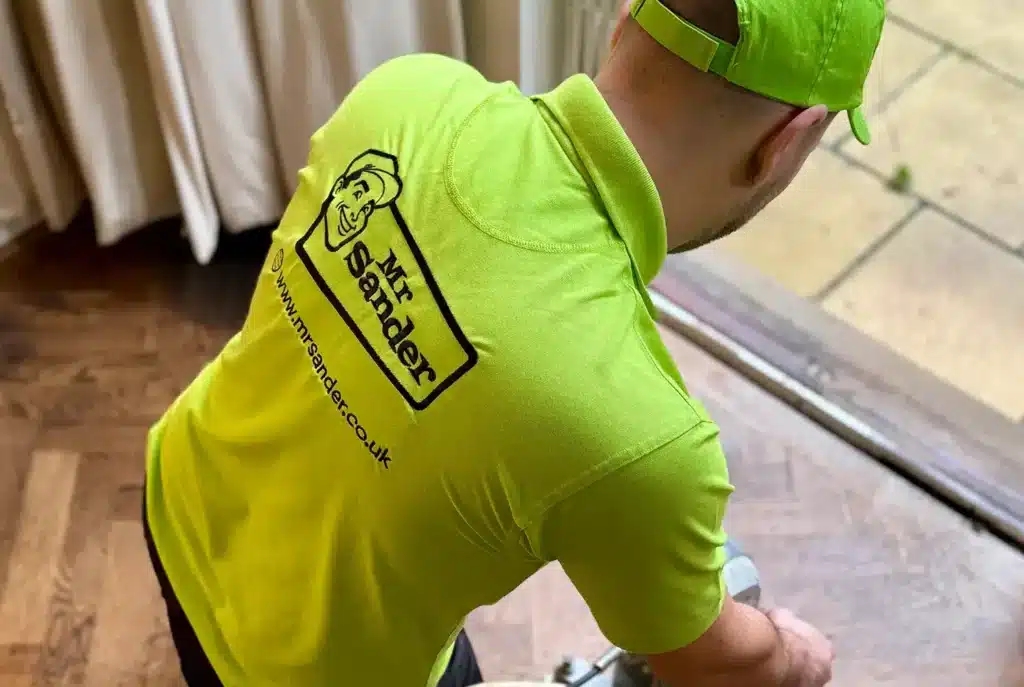
Maintaining Historical Accuracy
- Preserving Original Design: Ensuring that the restored floor accurately reflects the original design and craftsmanship is crucial, especially in historic buildings. This often entails extensive research, as well as the recreation of specific patterns or the use of specific wood staining techniques to match the original hues.
- Compliance with Heritage Regulations: In cases where the building is listed or has historical significance, any restoration work must comply with strict heritage regulations. Navigating these regulations requires specialist knowledge and, often, the involvement of conservation officers.
Environmental Considerations
- Managing Dust and Chemicals: The restoration process, especially in an active school environment, can generate significant amounts of dust and involve the use of chemicals, which require careful management. Ensuring good ventilation and choosing the right times for work to proceed are key considerations.
- Temperature and humidity control: Wood is sensitive to environmental conditions. Maintaining stable temperature and humidity levels is crucial during and after restoration to prevent further warping or damage.
Balancing Restoration with School Activities
- Minimizing Disruption: Schools are dynamic environments, necessitating the scheduling of restoration work to minimize disruption to school activities. This often means working during holidays or outside of school hours.
- Safety Considerations: Ensuring the safety of students, staff, and restoration workers is paramount. This involves setting up secure work areas and possibly temporary flooring to ensure that school activities can continue safely during the restoration.
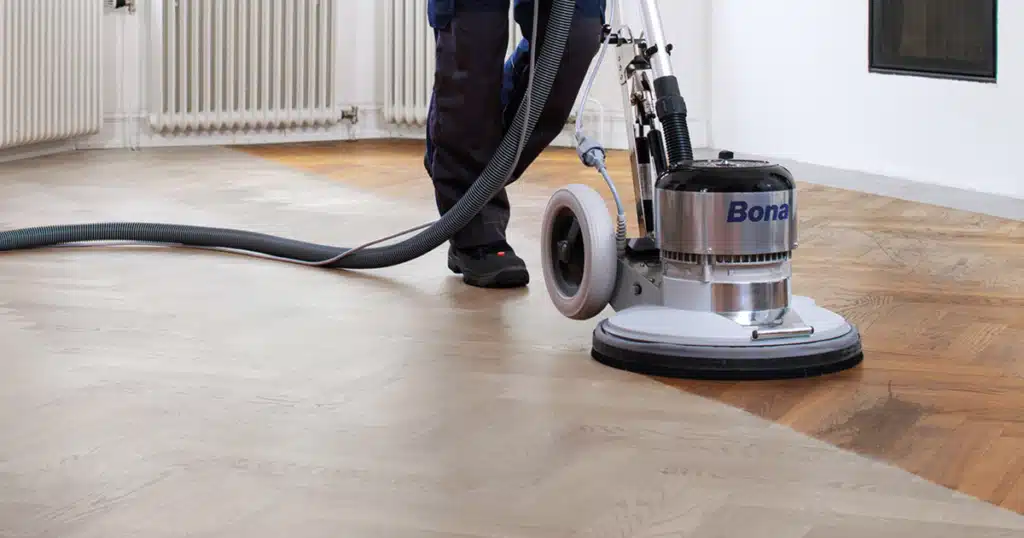
Expertise Required
The challenges of restoring parquet floors require not just technical skills but also a deep understanding of historical carpentry techniques. Successfully tackling these complex projects often requires skilled craftsmen who specialize in historical restorations. Addressing these challenges effectively is essential for a successful restoration that not only brings the floor back to its former glory but also ensures its longevity and continued use in the educational landscape. The restoration of parquet flooring, therefore, is not just a matter of repair but a comprehensive rejuvenation that honors its historical and aesthetic value.

The Role of British Craftsmanship
The restoration of parquet floors in British schools is not merely a maintenance task; it’s an art form steeped in history and tradition. British craftsmanship plays a pivotal role in this process, ensuring that each restoration project not only repairs damage but also preserves and celebrates the cultural heritage of the educational establishments. This section focuses on how local artisans contribute their expertise and the importance of supporting local businesses in these restoration endeavors.
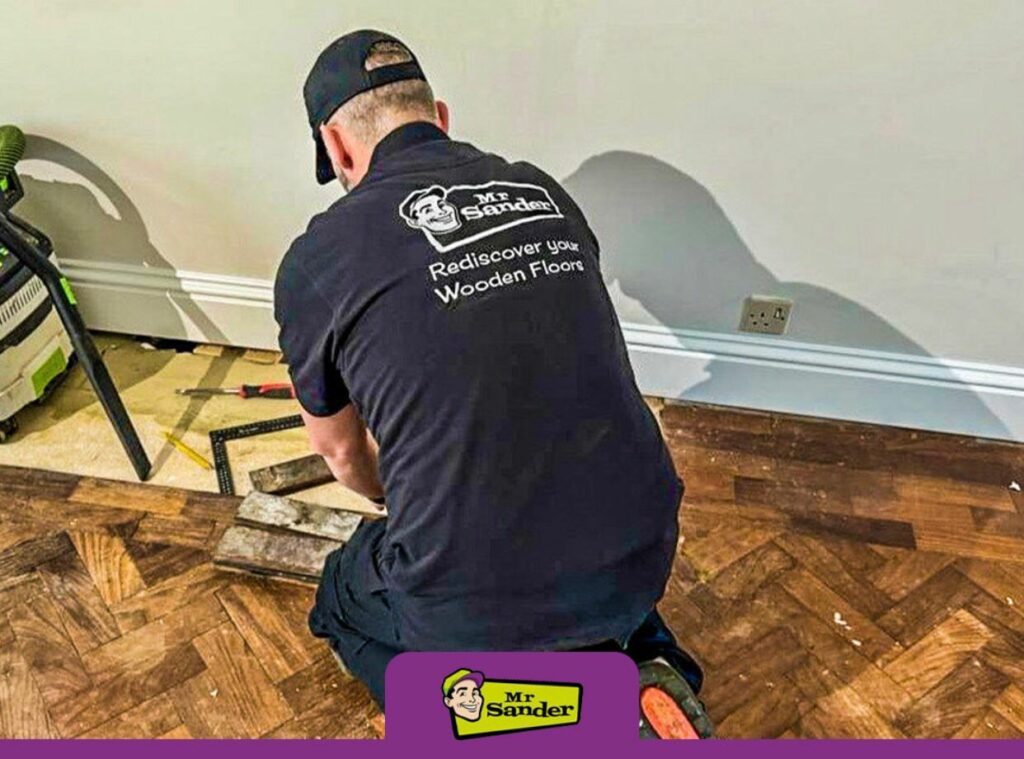
Skilled Artisans are Emphasized
- Expertise in Traditional Techniques: Generations of British craftsmen have honed their deep understanding of traditional woodworking and restoration techniques. Their expertise plays a crucial role in managing the intricate patterns and delicate nature of parquet floors, guaranteeing the respectful and precise treatment of each piece of wood.
- Custom Solutions for Unique Challenges: Every parquet floor restoration project comes with its own set of challenges, from matching historical patterns to dealing with extensive wear or damage. Local artisans can provide custom solutions that respect the floor’s original design while ensuring durability and longevity.
- Attention to Detail: The success of a restoration project often lies in the details. British craftsmen are known for their meticulous attention to detail, which is crucial in preserving the aesthetic and historical integrity of parquet floors. This includes matching the color and grain of the wood, recreating lost patterns, and applying finishes that are both beautiful and functional.
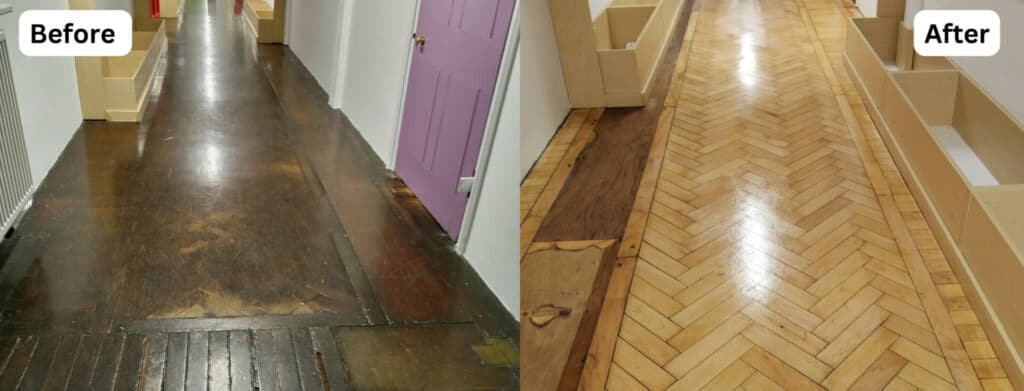
Supporting local businesses
- Economic Benefits: Employing local craftsmen boosts the local economy and preserves traditional skills that could otherwise disappear. Spending money on restoration projects benefits the community and contributes to the economic stability of local artisans.
- Sustainability: Working with local businesses often means shorter travel distances for materials and personnel, which can reduce the carbon footprint of a restoration project. Moreover, local artisans are more likely to source materials from nearby suppliers, promoting sustainable practices.
- Community and Cultural Pride: Engaging local craftsmen in restoration projects fosters a sense of community and pride. It allows schools to invest not just in the physical structure of their buildings, but also in the cultural fabric of their local area. This engagement helps to keep alive a narrative of local craftsmanship excellence and heritage preservation.
Contribution to Educational Environments
British craftsmanship’s involvement in the restoration of school parquet floors goes beyond physical repair. It serves as a practical demonstration of history and art, providing a learning opportunity for students. Schools can integrate the restoration process into educational content, such as history or art classes, where students learn about the craftsmanship involved, the history of the building materials, and the importance of preserving heritage.
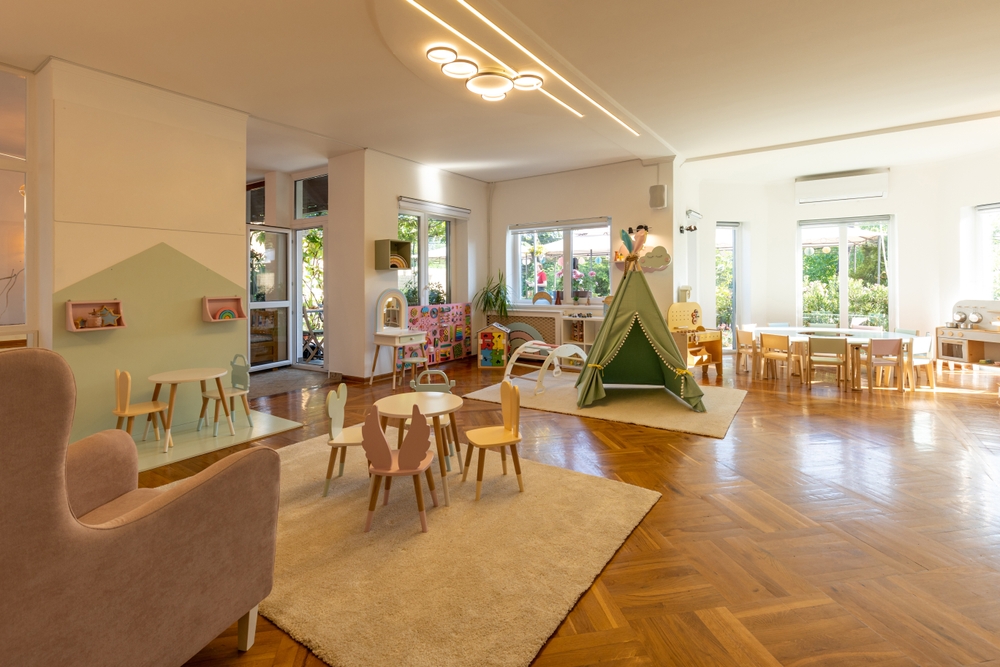
Maintenance Tips for Parquet Floors
Proper maintenance is crucial to preserving the beauty and extending the life of parquet floors, particularly in high-traffic areas like schools. Regular maintenance not only keeps these floors looking their best, but it also prevents the need for frequent major restorations. Here are some practical tips for the daily and periodic maintenance of parquet floors.
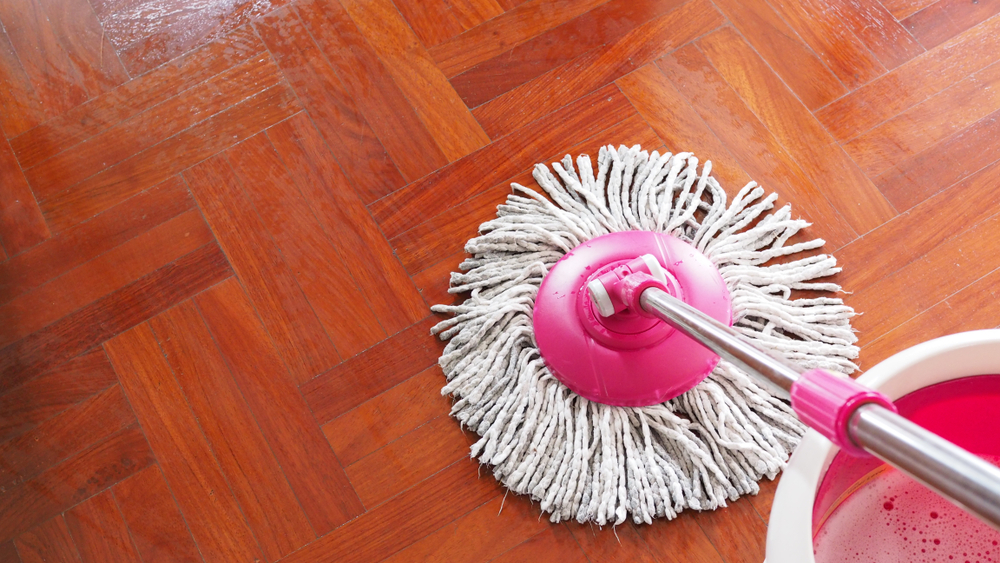
Daily Maintenance Advice
- Regular Sweeping and Dusting: Use a soft-bristled broom or a microfiber mop to gently sweep or dust the floor daily. This prevents dirt and grit from accumulating and scratching the wood surface.
- Immediate Spill Cleanup: To avoid water damage and staining, wipe up spills right away with a dry or slightly damp cloth.
- Use of Appropriate Cleaning Products: Avoid harsh chemicals and use cleaners specifically designed for wood floors. These cleaners help maintain the finish without causing damage.
Periodic maintenance advice
- Deep Cleaning: Schedule a deep cleaning every few months, depending on the level of foot traffic. Use a wood floor cleaner and a well-wrung mop to remove ingrained dirt without over-wetting the floor, which can cause wood swelling and warping.
- Protective Mats and Rugs: To reduce wear, place mats or rugs in high-traffic areas, such as entrances and hallways. Make sure these are non-slip and regularly clean them to prevent dirt from spreading across the floor.ctive Mats and Rugs: To reduce wear, place mats or rugs in high-traffic areas, such as entrances and hallways.loor.
- Furniture Pads: To prevent scratches and gouges when moving chairs, desks, and other furniture, attach felt pads to their legs.
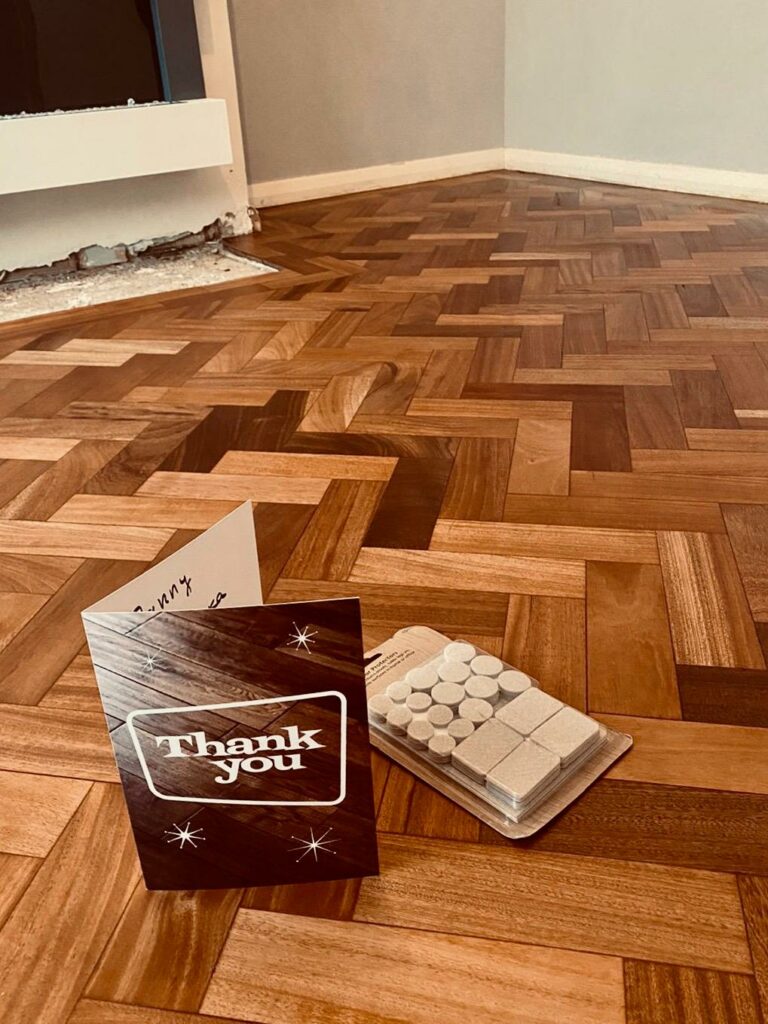
Professional upkeep and long-term care strategies
- Professional Polishing: Every few years, have the floor professionally polished to restore shine and refresh the protective layer. This process removes minor scratches and evens out the finish.
- Top Coating: Depending on the type and age of the floor, applying a new top coat of sealant can provide additional protection against wear and tear. Professionals who can assess the specific needs of the floor should do this.
- Scratch and Dent Repair: You can often repair small scratches and dents without refinishing the entire floor. You can use special wood markers, wax crayons, or putty to fill and color-match minor damage.
- Humidity Control: Maintain a stable indoor climate with humidity levels between 45% and 65% to prevent the wood from expanding, contracting, or warping.
- Sunlight Exposure: To minimize direct sunlight on the floor, use curtains or blinds, which can cause discoloration and fade over time.
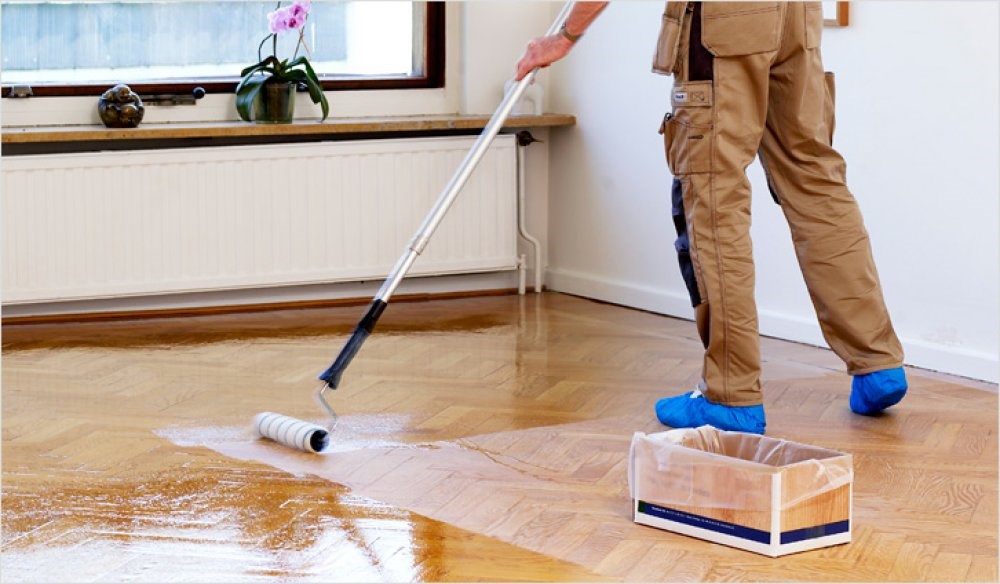
Conclusion
The restoration and maintenance of parquet floors in British schools is more than mere preservation; it is a commitment to honoring the rich educational and architectural heritage these floors represent. British craftsmanship meticulously restores these timeless features, imbuing them with renewed vitality to withstand the daily rigors of school life and continue their legacy of beauty and functionality. The process of transforming school parquet floors from worn-out surfaces to revitalized, elegant features teaches us the importance of preserving our past. It highlights how such endeavors not only safeguard physical assets but also nurture an environment that respects history and fosters learning. Schools with well-maintained parquet floors offer students a link to their institution’s heritage, providing a sense of continuity and pride that enhances the educational experience. Furthermore, employing local craftsmen not only preserves traditional skills but also boosts the local economy, fostering a positive cycle that enhances the community. The educational aspect of such restoration projects can also serve as a practical demonstration of applied arts and history, enriching the curriculum and providing students with a unique, hands-on learning experience. As we move forward, the drive to maintain these exquisite floors should remain a priority for educational institutions, not only for the sake of aesthetics but as a testament to the values of preservation, education, and community. In this way, the restoration and renewal of school parquet floors serve as a metaphor for educational renewal itself—each board polished and cared for, much like each student nurtured and valued, contributes to the splendid mosaic of learning and heritage.

Sanding
We provide virtually dust-free sanding with our continuous belt machinery with mobile extraction units, giving you a safer environment for your family.
Oiling
This organic finish not only adds beauty to your home but also has exceptional water-repellent characteristics, making it easier to clean and maintain.
Waxing
This natural floor finish offers the softest and most mellow appearance – and leaves your floor able to breath.
Buffing
Using soft buffing machines (and hand-polishing where required) will bring a wonderful sheen to your newly-finished floor.
Repairs
We offer a full assessment of your wooden floors to determine what repairs are needed to provide the perfect working surface for the later stages of sanding, staining and sealing.
Restoration
We offer a comprehensive restoration process designed to address floors that are improperly fitted or damaged over time through wear and tear.
Request a fixed price quote for your wood floor restoration now
Simply enter your postcode below to get started.
Services
Wood Floor Sanding Wood Floor Restoration Wood Floor Scratch Repair Squeaky Wood Floor Repair Parquet Floor Sanding Parquet Floor Restoration Commercial Floor Sanding Church Floor Sanding Community Centre Floor Sanding School Floor Sanding Gap Filling Gap Filling with ResinCopyright © Mr Sander®
Privacy & Cookies Terms & Conditions Complaints Procedure Cancellation Rights Sitemap